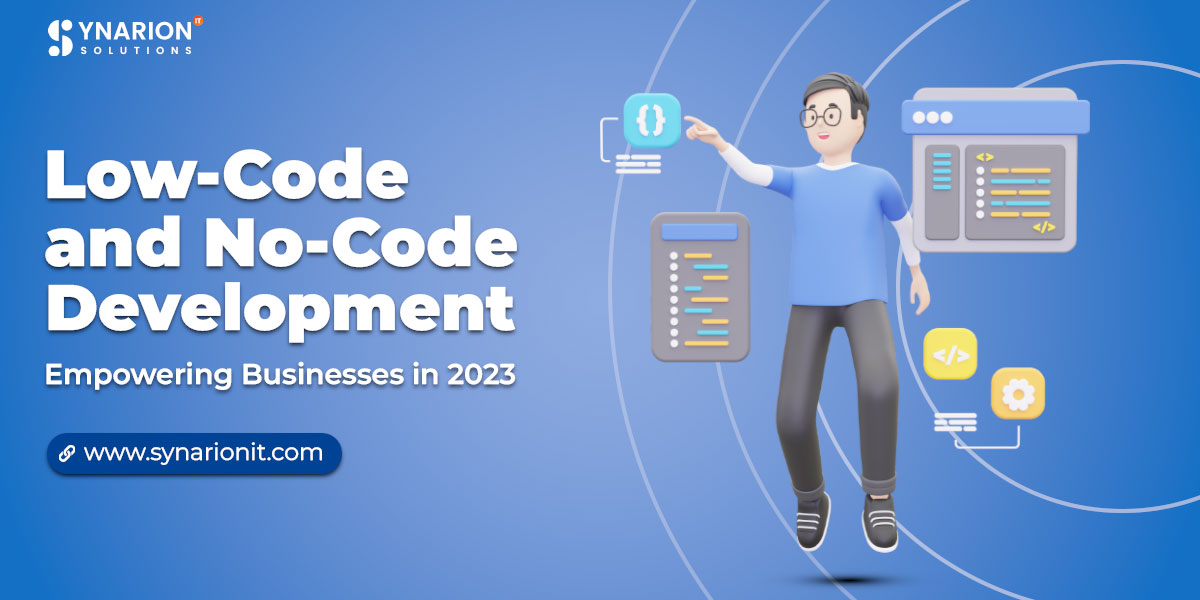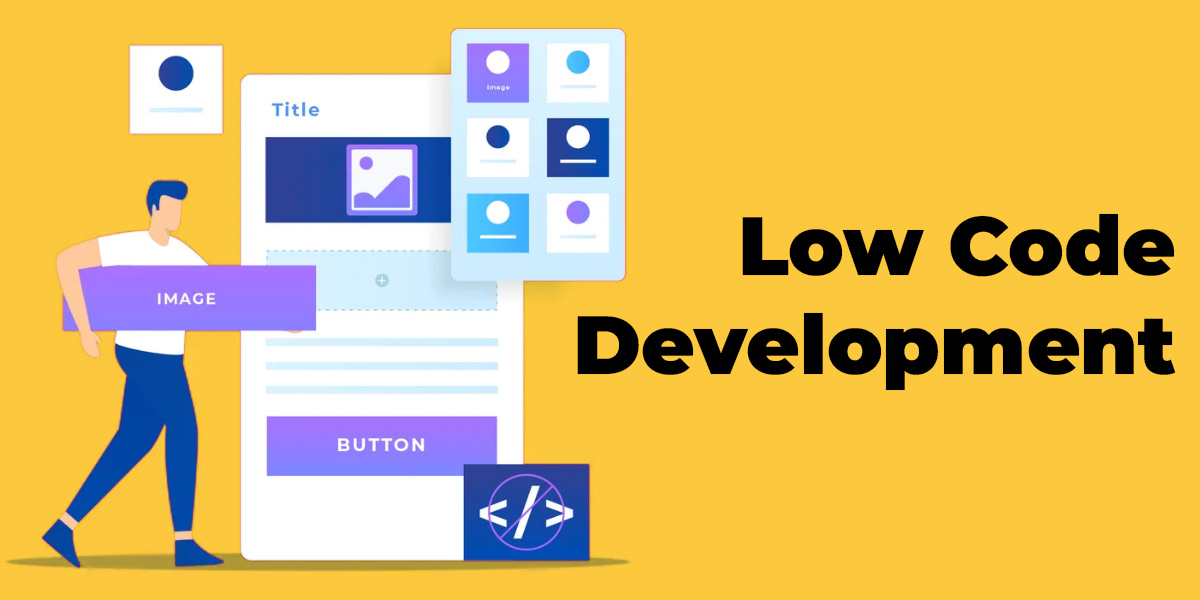In recent years, low-code and no-code development platforms have become major game-changers in the software development sector. These platforms provide a streamlined method for developing apps, enabling companies to create reliable applications with little to no coding work. In this article, we'll examine the ideas of minimal and no code, how they could affect organizations in 2023, and the benefits and drawbacks of using these platforms. We'll also discuss some of the market's most well-known low- and no-code platforms.
Recognizing No Code and Low Code:
No-code and low-code application development platforms have become widely used in the software industry thanks to their capacity to streamline and hasten the creation of new applications. These platforms enable users with different degrees of technical proficiency to build reliable apps without knowing much about coding. Understanding the distinctions between no and low codes is essential for comprehending their unique benefits and uses.
No Code Development
The construction of apps without writing code is called "no code development." Platforms that don't require coding give users visual interfaces and simple tools to create applications with a drag-and-drop capability, pre-configured elements, and predetermined logic. Users may concentrate on creating the application's user interface, setting processes, and interacting with data sources using these platforms, which have abstract, complicated coding duties.
Principal Features of No Code Development:
- Platforms that don't require any coding provide visual interfaces that let users visually create and set up their apps. Because of this, conventional coding languages and grammar are no longer necessary.
- Platforms that don't need users to write code offer a library of prebuilt processes, templates, and components that users can mix and alter to develop their applications. These parts frequently include widely used features like form generation, database integration, and user authentication.
- Users may easily create the application's user interface, construct data models, and establish logic flows by dragging and dropping objects into the canvas. As a result, users may visually organize and link components without writing code, streamlining the no code application development process.
Low Code Development
Low code development uses a visual user interface and only a little amount of coding. Compared to no-code platforms, low-code platforms offer a higher level of flexibility and customization, enabling users to contribute unique code snippets or scripts to increase the functionality of their apps. Although minimal code systems allow visual development, more complex changes could require coding skills.
Low code technology is a development strategy that enables users to build apps with little to no manual coding. Users may use the visual interface, pre-made components, and templates to develop and set up applications. Drag-and-drop capability, which allows users to visually organize and link components to create the application's logic and user interface, is frequently included in low-code platforms. Low-code platforms lessen the conventional coding required but still allow users to contribute custom code as needed.
Important Features of Low Code Development:
- Like no-code platforms, low-code platforms provide environments for visual development that streamline the process of creating applications. Using drag-and-drop components, users may graphically build and modify programs.
- Adding custom code snippets or scripts to improve the functionality of your apps is possible with low-code platforms. With this freedom, programmers with expertise may extend and alter programs beyond what the platform's prebuilt features can support.
- Integrating applications with external systems, databases, and APIs is made possible by the considerable integration options that low-code platforms offer their consumers. It makes it easier to integrate new infrastructure and transmit data seamlessly.
Business effects in 2023:
- Platforms for no-code and low-code application development have greatly sped this process. Businesses can create and deploy applications considerably more quickly than they might use conventional coding techniques because of streamlined interfaces, prebuilt components, and visual design tools. Thanks to this improved speed, businesses may adapt swiftly to market needs, provide new goods or services more quickly, and stay one step ahead of the competition.
- These users are sometimes referred to as citizen developers. Through this empowerment, people from different departments and job types can implement their ideas without largely depending on specialized development teams. Citizen developers may design solutions specifically suited to their requirements, increasing productivity.
- Platforms for development with little coding can save companies money. These platforms assist in decreasing development expenses by obviating the requirement for substantial coding and specialized development teams. Businesses can spend less on employing specialized experts, outsourcing development jobs, and deploying resources more effectively. A faster return on investment is also possible for enterprises because of the faster deployment and development times.
- Platforms with no code make collaborating easier for many parties engaged in the application development process. Business users, subject matter experts, and IT professionals may work together more productively using attractive interfaces and simple tools. Cross-functional teams can interact and coordinate their work more easily because of the platforms' shared language and visual representations.
Challenges and Things to Think About:
- While low-code and no-code platforms excel at helping developers create straightforward to moderately complicated apps, highly specialized or sophisticated applications could necessitate specific coding. It's critical to gauge the intricacy of your application's requirements and determine whether your selected platform can fulfill them. Complex integrations, sophisticated algorithms, or particular performance needs may require custom code or the application of conventional development techniques.
- Organizations must set up appropriate security and governance policies as citizen developers take increasing control of the application development process. Preserving sensitive information, maintaining data privacy, and adhering to applicable laws and standards is essential. Protecting applications created on platforms with no code or little code requires the implementation of suitable access restrictions, data encryption, and secure authentication techniques.
- Integrating applications created on no-code and low-code platforms with current systems, databases, and outside services may take more time and knowledge. It is crucial to consider how well the selected platform will work with your company's existing infrastructure. Assessing the platform's integration capabilities, support for industry-standard APIs, and capacity to interface with other systems is crucial.
- Vendor lock-in may occur if a certain no-code or low-code platform is chosen. Future platform switching may be difficult if the platform does not provide simple portability or interoperability with other systems. It is crucial to evaluate the platform's long-term sustainability and consider exit alternatives.
No Codes Low Code Platforms:
No code and low code platforms are tools and platforms that let users of various technological proficiency levels create apps without having a deep understanding of coding. These platforms make developing applications easier by offering visual interfaces, pre-built components, and automated functionality. Platforms that don't require coding concentrate on visual development and let users create apps using drag-and-drop features and established logic. Low-code platforms combine limited coding flexibility with visual development by enabling users to upload their own scripts or code snippets to increase the functionality of their apps.
Platforms with no code or reduced code offer the following advantages:
- Accessibility: They allow anyone with little or no coding experience to participate in application development, giving business users and citizen developers the freedom to design original solutions.
- Speed: These platforms' visual interfaces and pre-built components speed up the development process, making it possible to create and deploy applications more rapidly.
- Cost savings: By lessening the need for specialized experts and specific code, these platforms can aid in bringing down development costs and more effectively allocating resources.
- Cooperation: No-code, low-code platforms enable cooperation between various stakeholders, enhancing the efficiency of work between business users, subject matter experts, and IT specialists.
- Flexibility: These platforms are adaptable and flexible, allowing applications to grow and alter as business requirements do.
Low-code and no-code development platforms have become effective tools that will empower enterprises in 2023. These platforms have revolutionized the conventional software development process by making it easier and faster to create applications, even for non-programmers.
Users of no-code platforms may create applications using visual interfaces, drag-and-drop capabilities, and pre-built components without writing any code. On the other hand, low-code platforms find a mix between visual development and constrained coding freedom, allowing users to include specific code snippets as necessary.
Low-code and no-code development have advantages. Businesses may have more speed and agility, allowing them to react rapidly to market needs and develop new goods or services. Employees from all departments and citizen developers may actively participate in the development process, encouraging innovation inside the company. Additionally, these platforms provide cost benefits by eliminating the requirement for specialized developers and maximizing resource usage. Low-code and no-code development platforms have evolved into indispensable tools for organizations in the quickly changing digital ecosystem, allowing them to expedite development, promote creativity, and find cost-effective solutions. Businesses may use these platforms to promote development, enhance operational effectiveness, and maintain competitiveness in the fast-paced business climate of 2023 by embracing them and recognizing their potential and limits.




Comments
Post a Comment